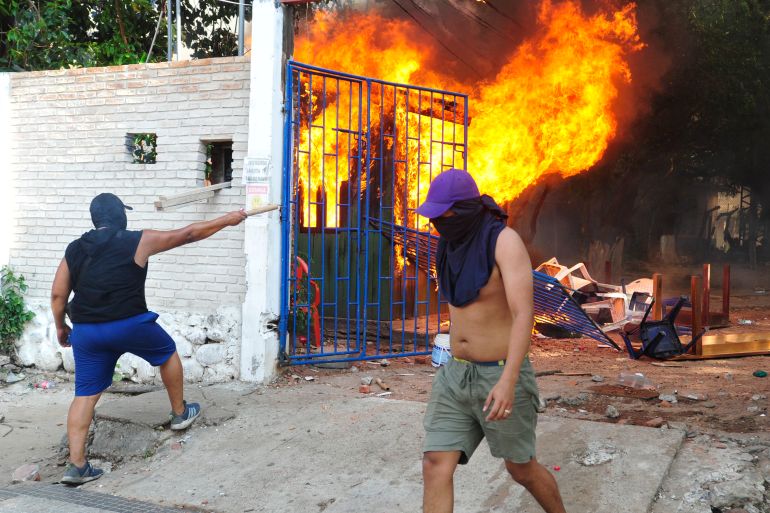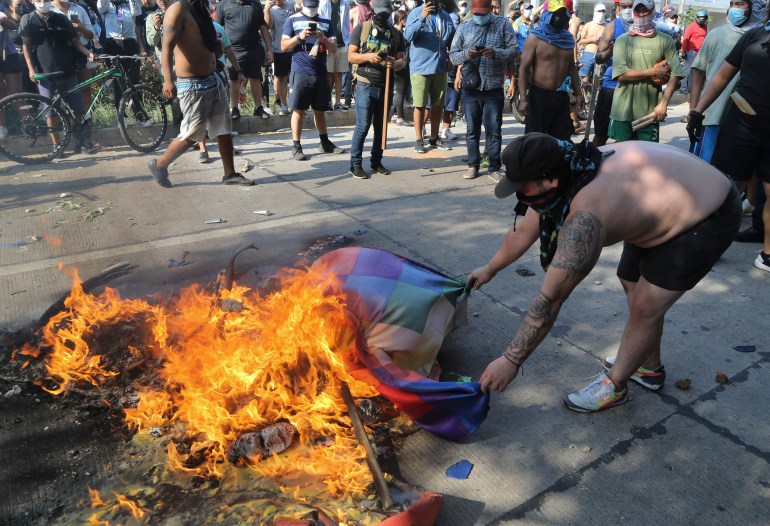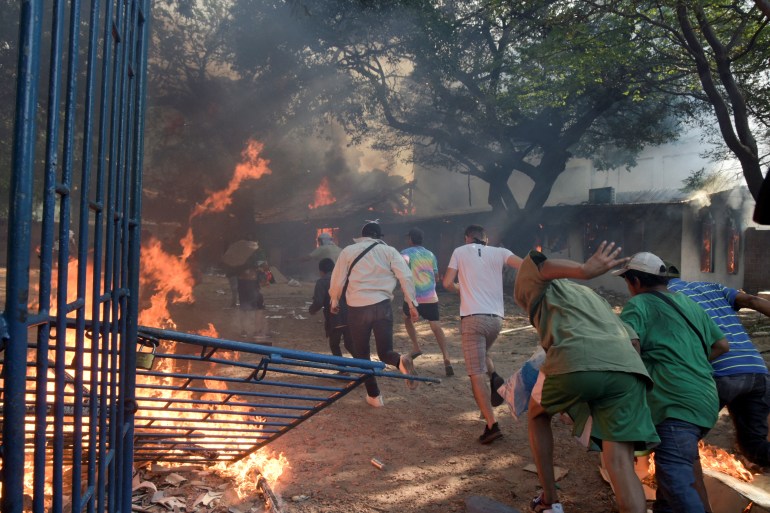Census delay sparks deadly strikes in Bolivia’s Santa Cruz region
Bolivia’s census, postponed until 2024, is expected to shift legislative seats toward the growing Santa Cruz department.

Six months ago, Miguel Nunez Saenz thought he would be spending November 16 at home in Santa Cruz in eastern Bolivia, waiting patiently for census workers to knock on his door and take his personal details.
Instead, the 47-year-old teacher spent the day at a barricade made of stones and tyres, flying Santa Cruz’s green-and-white flag. He and his neighbours are taking part in a long-running strike to protest a government decision to delay the national census until 2024.
Keep reading
list of 3 itemsBolivian ex-President Anez jailed for 10 years for mounting coup
Bolivia: In the clouds
“It’s really important because it means resources for our department and our communities,” Nunez Saenz told Al Jazeera via WhatsApp from the blockade. “We need schools, hospitals and lots of things to improve the quality of living for the inhabitants [here].”
The left-wing government of President Luis Arce decided to push the census date back after local authorities raised concerns about COVID-19, the challenge of incorporating Bolivia’s Indigenous languages, and the fact that many rural workers travel in November for the sugarcane harvest.
But the Pro Santa Cruz Civic Committee, the powerful right-wing group leading the strike, believes the delay is politically motivated. Its members predict the census will show population growth in cities like Santa Cruz, Bolivia’s most populous city and a major agricultural hub.
Voters in Santa Cruz are more likely to oppose the current government. In the 2020 general elections, the ruling party, Movement Towards Socialism (MAS), obtained 55 percent nationally but just 36 percent in Santa Cruz.
Meanwhile, Creemos, a Christian conservative coalition led by former Civic Committee president Luis Fernando Camacho, obtained 45 percent of the vote there.
In Bolivia, census data is used to determine the distribution of public funds. The number of legislative seats allocated to each of Bolivia’s nine departments in the lower house is also partly based on population size. The last census was held in 2012.
The strike has become violent in some areas, as demonstrators block roads and clash with the police and opposing groups that are trying to clear the routes. For many in Bolivia, the dispute carries echoes of the conflict that forced long-running left-wing president Evo Morales out of power amid controversial fraud allegations in 2019.
Minister of the Presidency Maria Nela Prada said on November 10 that four people had been killed in the strike, which started on October 22. A rural workers’ union building was set ablaze on November 11, and the government ombudsman’s office says it has registered 42 cases of human rights violations, including murder, sexual assault and attacks against journalists.

On Saturday, President Arce approved a decree stating that the census would be carried out by the country’s National Institute of Statistics on March 23, 2024.
A previous decree had said the census would be held in May or June of that year at the latest, but a commission created in response to the strike concluded it would be possible to do the survey in March or April 2024 instead. The new decree also states that the government would redistribute public funds in September 2024 based on preliminary census results.
Arce tweeted that the decree “fulfils the request of over 300 of the country’s elected authorities and the recommendations of the technical commission”.
But lawmakers have already proposed bills countering the decree, offering alternatives they hope will be taken up by Bolivia’s congress.
During a rally at Santa Cruz’s Christ the Redeemer monument following the decree, the Civic Committee’s leaders said that the strike would continue, calling on other cities in Bolivia to support their demands.
“We have already obtained important achievements. Today, we have to keep fighting,” Civic Committee President Romulo Calvo said, speaking via a recorded video. He is currently under house arrest on charges related to his work at a health insurance fund.

Ana Paola Garcia Villagomez, director of the Casa de la Mujer women’s refuge in Santa Cruz, told Al Jazeera that nearby protesters were attempting to prevent survivors of domestic violence from passing the roadblocks and were harassing the shelter’s workers for not adhering to the strike.
“The women who come in search of guidance or help or to report [violence], how are they going to know we’re open if all sides are closed off?” she said.
When Casa de la Mujer staff cut a rope that barred the last open route to the women’s shelter, a large group of men came and screamed at them, threatening to occupy the building, Garcia Villagomez said.
Since then, protesters outside have been setting off firecrackers and rockets every 15 minutes to disrupt the shelter’s activities. “It’s a display of the far right that exists in Bolivia, together with a point of view that is fascist even,” she said.
The Inter-American Commission on Human Rights sent a tweet condemning the harassment of Casa de la Mujer staff and clients, as well as denouncing other acts of violence stemming from the protests.
Strike organisers have been holding “supply days” periodically, allowing movement through the blockades to enable locals to stock up on food, gasoline and other basic goods. But many of the city’s poorest residents, who rely on daily work for their income, are struggling to survive, Garcia Villagomez said.

Nunez Saenz said he feels the strike is justified despite its impact on the poor and most vulnerable. He worries that, elsewhere in the region, “zurdos” – loosely translated as “Commies” or “leftists” – are “destroying” countries like Cuba, Venezuela and Nicaragua. Citizens there “don’t have work or good food”, he said.
“It’s better to experience want for a few days than to live a miserable life your whole life,” Nunez Saenz added.
According to Carlos Cordero, a political scientist at the Catholic University of Bolivia, the strike is not just about the national census but is also a struggle for political and economic power.
Data from municipal governments, universities and other sources indicate that Santa Cruz’s population has indeed grown, he said. This would present the government with the politically unpalatable job of cutting budgets and congressional seats from some areas and allocating more funds and representation to Santa Cruz as the 2025 presidential election draws near.
“To give Santa Cruz the seats it’s demanding as a function of its population growth, they’ll have to take them from a department or several departments,” Cordero said. “It’s a zero-sum game. The winner gets them at the cost of someone who loses.”
The Civic Committee is demanding a legally binding commitment to the census date, the allocation of funds and the congressional seats, suggesting a possible resolution to the conflict. Meanwhile, nearly a month has passed, and Santa Cruz is still paralysed.